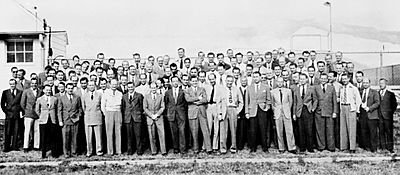Oscar Holderer facts for kids
Quick facts for kids
Oscar Holderer
|
|
|---|---|
| Born | November 4, 1919 Prüm, Germany
|
| Died | May 5, 2015 (aged 95) Huntsville, Alabama, United States
|
| Nationality | German, American |
| Scientific career | |
| Fields | Aeronautics |
| Institutions | Peenemünde Fort Bliss Redstone Arsenal Marshall Space Flight Center |
Oscar Carl Holderer (November 4, 1919 – May 5, 2015) was a talented engineer. He worked for Germany during World War II. Later, he moved to the United States. There, he helped with the exciting Apollo program, which sent humans to the Moon.
| Top - 0-9 A B C D E F G H I J K L M N O P Q R S T U V W X Y Z |
Early Life and Beginnings
Oscar Carl Holderer was born on November 4, 1919. His hometown was Prüm, Germany. His parents were Richard and Helene Grawe Holderer. He had a brother named Erich Joseph. He also had a sister named Doris.
A Career in Rocket Science
During World War II, Holderer worked as an engineer. He was part of the German military. He worked under a famous rocket scientist, Wernher von Braun.
Joining Operation Paperclip
After the war, the United States wanted to improve its rocket technology. They started a secret project called Operation Paperclip. This project brought German scientists to America. Oscar Holderer was one of these scientists. He arrived in 1945.
The Paperclip team first worked in White Sands, New Mexico. In 1950, they moved to Redstone Arsenal in Alabama. This area became a key place for rocket development.
Building a New Life in Alabama
When Oscar Holderer arrived in Alabama, he rented a home. He then designed and built his own house. He chose a country spot in northwest Huntsville. He kept adding to his property over the years. By 2008, it included a house, a guest house, and a large workshop. He lived there for the rest of his life. In 1955, Oscar Holderer became an American citizen.
Expert in Aerodynamics
Holderer was an expert in aerodynamics. This is the study of how air moves around objects. He helped bring America's first rocket wind tunnel from Germany. He set it up for early rocket tests.
At Redstone Arsenal, he worked as a mechanical engineer. He designed and built many things. He designed the special wind tunnel used for testing the Saturn V rocket. This rocket later powered Apollo 11 to the Moon. Holderer was amazed by the project's goals. The same wind tunnel is still used by NASA today.
Life After Retirement
Oscar Holderer was promoted several times. But he preferred hands-on work over managing people. He retired in 1974. However, he kept designing equipment for space missions.
He designed training equipment for the U.S. Space & Rocket Center's Space Camp. This included a multi-axis trainer and a one-sixth gravity chair. This equipment is still used by young space explorers today. He also helped turn a jetliner's tail into a movie theater for the museum.
In 1979, Alabama wanted to display a Saturn IB rocket. Holderer was asked to help with this big project. He remained active with the Space & Rocket Center until his death.
Later Life and Legacy
Oscar Holderer passed away on May 5, 2015. He was 95 years old. He died in Huntsville, Alabama. He was survived by his second wife, Jan Smith Dunlap Holderer. He had two sons, Thomas and Michael, with his first wife, Inge Spors Holderer. He also had four grandchildren and three great-grandchildren.
Holderer was the last known surviving member of the original Operation Paperclip team. A space historian named Ed Buckbee described him as "a very talented man." He was skilled in both aerodynamics and design.
Oscar Holderer received 19 patents during his life. A patent protects an invention. In 2008, he was honored by being inducted into the Space Camp Hall of Fame.
Images for kids



